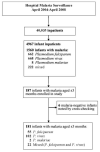Vivax malaria: a major cause of morbidity in early infancy
- PMID: 19438395
- PMCID: PMC4337979
- DOI: 10.1086/599041
Vivax malaria: a major cause of morbidity in early infancy
Abstract
Background: In areas where malaria is endemic, infants aged <3 months appear to be relatively protected from symptomatic and severe Plasmodium falciparum malaria, but less is known about the effect of Plasmodium vivax infection in this age group.
Methods: To define malaria morbidity in the first year of life in an area where both multidrug-resistant P. falciparum and P. vivax are highly prevalent, data were gathered on all infants attending a referral hospital in Papua, Indonesia, using systematic data forms and hospital computerized records. Additional clinical and laboratory data were prospectively collected from inpatients aged <3 months.
Results: From April 2004 through April 2008, 4976 infants were admitted to the hospital, of whom 1560 (31%) had malaria, with infection equally attributable to P. falciparum and P. vivax. The case-fatality rate was similar for inpatients with P. falciparum malaria (13 [2.2%] of 599 inpatients died) and P. vivax malaria (6 [1.0%] of 603 died; P= .161), whereas severe malarial anemia was more prevalent among those with P. vivax malaria (193 [32%] of 605 vs. 144 [24%] of 601; P= .025). Of the 187 infants aged <3 months, 102 (56%) had P. vivax malaria, and 55 (30%) had P. falciparum malaria. In these young infants, infection with P. vivax was associated with a greater risk of severe anemia (odds ratio, 2.4; 95% confidence interval, 1.03-5.91; P= .041) and severe thrombocytopenia (odds ratio, 3.3; 95% confidence interval, 1.07-10.6; P= .036) compared with those who have P. falciparum infection.
Conclusions: P. vivax malaria is a major cause of morbidity in early infancy. Preventive strategies, early diagnosis, and prompt treatment should be initiated in the perinatal period.
Figures


References
-
- McGregor IA. Epidemiology, malaria and pregnancy. Am J Trop Med Hyg. 1984;33:517–25. - PubMed
-
- Bruce-Chwatt LJ. Malaria in infants and children in Southern Nigeria. Ann Trop Med Parasitol. 1952;46:173–99. - PubMed
-
- Riley EM, Wagner GE, Akanmori BD, Koram KA. Do maternally acquired antibodies protect infants from malaria infection? Parasite Immunol. 2001;23:51–9. - PubMed
-
- Wagner G, Koram K, McGuinness D, Bennett S, Nkrumah F, Riley E. High incidence of asymptomatic malaria infections in a birth cohort of children less than one year of age in Ghana, detected by multicopy gene polymerase chain reaction. Am J Trop Med Hyg. 1998;59:115–23. - PubMed
Publication types
MeSH terms
Grants and funding
LinkOut - more resources
Full Text Sources
Miscellaneous

